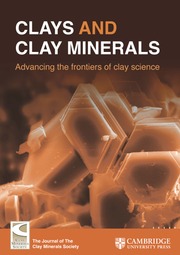Crossref Citations
This article has been cited by the following publications. This list is generated based on data provided by
Crossref.
Egan, Robert S.
2010.
Recent literature on lichens—218.
The Bryologist,
Vol. 113,
Issue. 3,
p.
690.
Stachnik, Łukasz
and
Uzarowicz, Łukasz
2011.
The Relationship between Dissolved Solids Yield and the Presence of Snow cover in the Periglacial Basin of the Obruchev Glacier (Polar Urals) during the Ablation Season.
QUAGEO,
Vol. 30,
Issue. 1,
p.
95.
Lesovaya, S. N.
Goryachkin, S. V.
and
Polekhovskii, Yu. S.
2012.
Soil formation and weathering on ultramafic rocks in the mountainous tundra of the Rai-Iz massif, Polar Urals.
Eurasian Soil Science,
Vol. 45,
Issue. 1,
p.
33.
Lessovaia, Sofia
Dultz, Stefan
Polekhovsky, Yurii
Krupskaya, Viktoria
Vigasina, Marina
and
Melchakova, Lubov
2012.
Rock control of pedogenic clay mineral formation in a shallow soil from serpentinous dunite in the Polar Urals, Russia.
Applied Clay Science,
Vol. 64,
Issue. ,
p.
4.
Egli, Markus
Lessovaia, Sofia N.
Chistyakov, Kirill
Inozemzev, Svyatoslav
Polekhovsky, Yurii
and
Ganyushkin, Dmitry
2015.
Microclimate affects soil chemical and mineralogical properties of cold alpine soils of the Altai Mountains (Russia).
Journal of Soils and Sediments,
Vol. 15,
Issue. 6,
p.
1420.
Hseu, Zeng-Yei
Zehetner, Franz
Ottner, Franz
and
Iizuka, Yoshi
2015.
Clay-Mineral Transformations and Heavy-Metal Release in Paddy Soils Formed on Serpentinites in Eastern Taiwan.
Clays and Clay Minerals,
Vol. 63,
Issue. 2,
p.
119.
Lessovaia, Sofia N.
Goryachkin, Sergey
Polekhovsky, Yury
Ershova, Viktoria
and
Filimonov, Alexey
2016.
Biogenic—Abiogenic Interactions in Natural and Anthropogenic Systems.
p.
223.
Lessovaia, Sofia N.
Dultz, Stefan
Plötze, Michael
Andreeva, Natalia
Polekhovsky, Yury
Filimonov, Alexey
and
Momotova, Olesya
2016.
Soil development on basic and ultrabasic rocks in cold environments of Russia traced by mineralogical composition and pore space characteristics.
CATENA,
Vol. 137,
Issue. ,
p.
596.
Sumina, Olga I.
and
Lessovaia, Sofia N.
2016.
Biogenic—Abiogenic Interactions in Natural and Anthropogenic Systems.
p.
249.
Cardelli, Valeria
Cocco, Stefania
Agnelli, Alberto
Nardi, Serenella
Pizzeghello, Diego
Fernández-Sanjurjo, Maria
and
Corti, Giuseppe
2017.
Chemical and Biochemical Properties of Soils Developed from Different Lithologies in Northwestern Spain (Galicia).
Forests,
Vol. 8,
Issue. 4,
p.
135.
Lessovaia, Sofia N.
Gerrits, Ruben
Gorbushina, Anna A.
Polekhovsky, Yury S.
Dultz, Stefan
and
Kopitsa, Gennady G.
2020.
Processes and Phenomena on the Boundary Between Biogenic and Abiogenic Nature.
p.
501.
Zigova, Anna
2021.
Soil development on Proterozoic and Paleozoic rocks of central Bohemia.
Acta Geodynamica et Geomaterialia,
p.
437.
Akbari, S.
Karimi, A.
Lakzian, A.
and
Fotovat, A.
2022.
Pedogenesis and Distribution of Ni and Cr in an Ultramafic Soil Toposequence under Arid Climate.
Eurasian Soil Science,
Vol. 55,
Issue. 4,
p.
520.
Han, Shujun
Lӧhr, Stefan C.
Abbott, April N.
Baldermann, Andre
Voigt, Martin
and
Yu, Bingsong
2022.
Authigenic clay mineral evidence for restricted, evaporitic conditions during the emergence of the Ediacaran Doushantuo Biota.
Communications Earth & Environment,
Vol. 3,
Issue. 1,
Gverić, Zvonka
Rubinić, Vedran
Kampić, Štefica
Vrbanec, Pavao
Paradžik, Anja
and
Tomašić, Nenad
2022.
Clay mineralogy of soils developed from Miocene marls of Medvednica Mt., NW Croatia: Origin and transformation in temperate climate.
CATENA,
Vol. 216,
Issue. ,
p.
106439.
Olsen, Amanda Albright
Bodkin, Michael A.
and
Hausrath, Elisabeth M.
2023.
Quantifying early mineral weathering reactions in serpentinite bedrock.
Applied Geochemistry,
Vol. 148,
Issue. ,
p.
105543.
Han, Shujun
Löhr, Stefan C
Abbott, April N
Baldermann, Andre
Shields, Graham A.
Cui, Huan
Kaufman, Alan J
Chen, Bo
and
Yu, Bingsong
2024.
Authigenic clay mineral constraints on spatiotemporal evolution of restricted, evaporitic conditions during deposition of the Ediacaran Doushantuo Formation.
Earth and Planetary Science Letters,
Vol. 626,
Issue. ,
p.
118524.
Kempton, Richard
Perera, Siyumini
Faiz, Mohinudeen
and
Verrall, Michael
2024.
A Mesoproterozoic (~1.25 Ga) ‘fossilised’ oil column in the Moroak Sandstone of the Beetaloo Sub-basin, NT.
Australian Energy Producers Journal,
Vol. 64,
Issue. 1,
p.
169.
Liao, Qinpeng
Gu, Huangling
Qi, Chongchong
Chao, Jin
Zuo, Wenping
Liu, Junqin
Tian, Chen
and
Lin, Zhang
2024.
Mapping global distributions of clay-size minerals via soil properties and machine learning techniques.
Science of The Total Environment,
Vol. 949,
Issue. ,
p.
174776.

